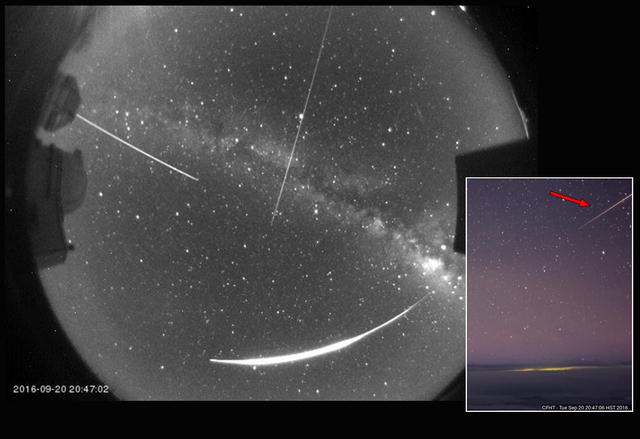It was before moonrise Sept. 20 when Subaru Telescope astronomer Ichi Tanaka went to do a routine check of sky conditions on Mauna Kea. ADVERTISING It was before moonrise Sept. 20 when Subaru Telescope astronomer Ichi Tanaka went to do
It was before moonrise Sept. 20 when Subaru Telescope astronomer Ichi Tanaka went to do a routine check of sky conditions on Mauna Kea.
At the same time, somewhere miles above Earth, a meteor hit the atmosphere and burned its way across the sky.
Tanaka saw the flash of light, which was so striking he wondered if it could have been a fireball: a meteor that appears as bright as the planet Venus.
It was. The fireball was caught speeding across the sky by the University of Hawaii telescope’s All-Sky Camera, looking like a “heavenly Cheshire cat,” said Subaru spokeswoman Saeko Hayashi.
Shooting stars occur nearly every night, she said, but it’s extremely rare to see one so bright.
“We are really amazed by it,” Tanaka said. The fireball was the largest he had ever seen in 10 years working at the observatory.
The tail end of the fireball was also caught by the CloudCam cloud monitor camera of the Canada-France-Hawaii telescope.
“If we (didn’t) have the camera, no one would recognize this kind of big event,” Tanaka said. “It’s kind of by chance that we captured this huge historic line. It was unexpected.”
Subaru telescope operator Mike Lemmen also spotted the flash of light, and said in a written statement that he felt lucky to have seen the event, calling it a “reward for working the night shift on the mountain.”
The sprawling Milky Way also appears in the All-Sky Camera photo.
“(That) in itself is already a very special thing over Mauna Kea,” Hayashi said.
Tanaka said the photo capture was important for future astronomy education.
“I really hope that kind of a picture motivates students to look at the sky,” he said.
To check sky conditions on Mauna Kea, visit http://mkwc2.ifa.hawaii.edu/current/cams/.
Email Ivy Ashe at iashe@hawaiitribune-herald.com.



